Modern rain jackets and rain pants can be made from several different materials, but most of these are derived from nylon or polyester to some extent.
Both nylon and polyester are good choices when it comes to rain gear, but there are some crucial differences that you should know before buying your new jacket or rain pants.
Whereas nylon is the softest, strongest and lightest of the two, polyester is slightly more water resistant, is cheaper, more UV-resistant and is less noisy to wear!
When it comes to modern rain apparel, most people want something functional that can stand the challenges of everything from a walk in the rain to a ten day hike full of rain showers.
Polyester and nylon are the most commonly used synthetic fabrics. They both have a wide range of practical uses, such as for clothing, tents, and even upholstery.
So let’s look into these two materials to figure out what to consider and which one is better for your rain gear!
Contents
Introduction to Nylon
Nylon was the first synthetic fabric used for jackets.
Nylon is a fabric made from polyamides and it was originally made to replace soft natural fabrics such as silk.
However, today it is commonly used for jackets, ropes, tents, sleeping bags, and also for parachutes and hot air balloons due to its lightweight and high strength!
Compared to polyester, nylon is more stretchable and lighter for the same strength. Depending on the coating, it is as waterproof and abrasive resistant, but also more expensive. Polyester, on the other hand, is more heat and UV resistant and does not expand when wet.
Most modern nylons are made with the so-called rip-stop technique, which means that strong threads (thicker than the main material) are woven into the fabric at regular intervals.
Rip-stop ensures that any tears of the thin main fabric do not propagate along and end up tearing the whole sheet apart.
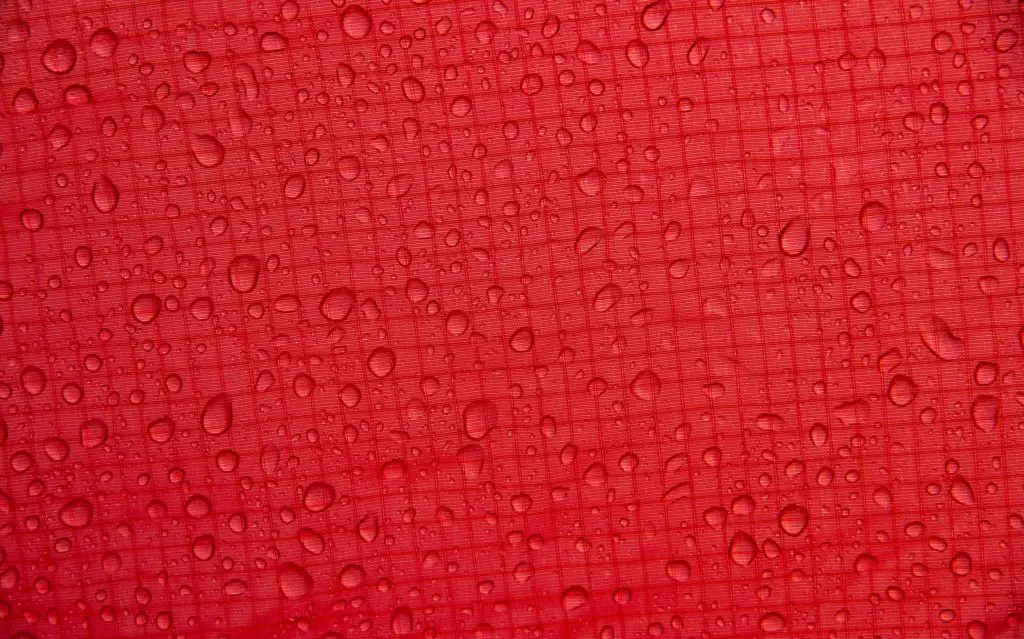
Nylon is the material of choice for weight-critical products such as ultra-light camping tents or sleeping bags. This is because it can be made down to ultrafine threads that allow for the very thin fabric to be made.
Technically, nylon can be made up to around 1680D and down to a thickness of 7D, whereas polyester can only be made to a density of 20D (almost three times as heavy!).
Read more about nylon in my recent post about the different types of nylon here.
What kind of fabric is polyester?
Polyester was invented only a few years after nylon in 1941 and while similar to nylon, it had obvious differences – mainly its price!
Polyester is made from polyethylene terephthalate also known as PET, which may come from oil or from reused plastic materials.
The polyester plastic itself is used for everything from tents and drinking bottles to TV screens, umbrellas, and insulation material for your sleeping bag or “down” jacket!
Garments made from thin threads of polyester are mostly used for clothing, furniture, or tents.
Polyester is suitable for (outdoor) clothing as it is cheap, though, does not discolor in UV/sunlight, and is often regarded as quite rough.
For example, polyester is a major component (mixed with cotton) of the ultra-durable G-1000 fabric from the Fjällräven outdoor brand.
And polyester “wool” is often used as a filling material instead of down for sleeping bags!
When used in outdoor products such as in tents, thicker polyester threads are used because polyester is not as strong as nylon and therefore more polyester material (thicker threads) are needed to obtain the same strength.
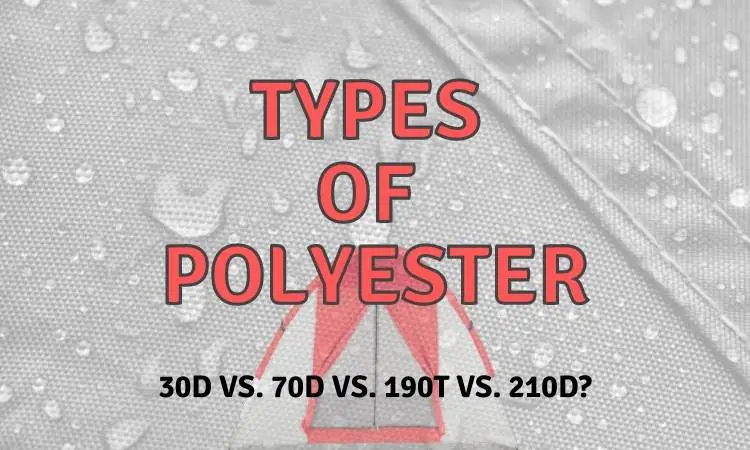
In addition, it is simply not technically possible to make polyester threads thinner than a thickness of 20D (whereas nylon can be spun down to 7D!).
This generally makes products with polyester, including tents, heavier than comparable products where nylon is used.
As for nylon, polyester comes in different thicknesses that you can read more about here. Some of the thickest polyester types are only used for the groundsheet, backpacks and the raingear discussed here.
Is Nylon or Polyester Better for Raincoats?
Both materials are widely used for raincoats and are also integrated in many membrane technologies like Gore-Tex.
Nylon is great for the more lightweight applications where the price is less of an issue. It will be less prone to dirt accumulation and more resistant to tears. It is also softer and many people find it more comfortable to wear.
However, most modern jackets have a softer layer of e.g. tricot lining that makes softness less of a problem.
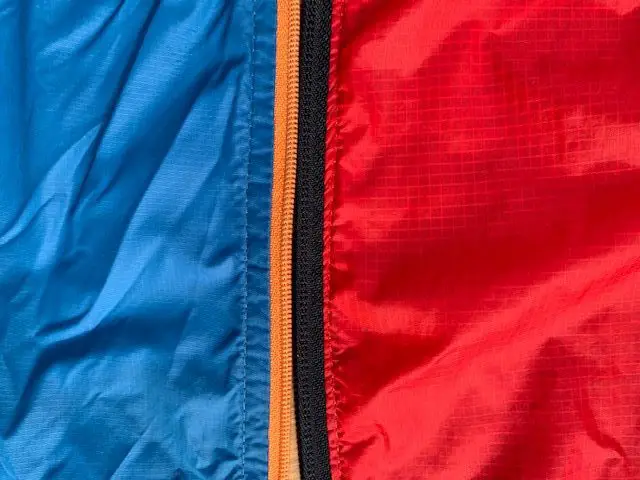
Nylon is often used in lightweight and packable cycling or hiking jackets because less material is needed compared to a polyester jacket with similar functionalities.
Nylon is much stronger but repeated packing and unpacking does cause slightly more wrinkles in the jacket compared to polyester jackets (sew my photo above!).
Polyester is considered more breathable, somewhat more durable, and will last longer in the sun compared to nylon. However, polyester is also colder to wear compared to nylon of the same thickness.
These are nice features if you plan to use your raingear a lot in more sunny climates or just for everyday jackets that are worn a lot.
So the choice of material basically comes down to your preference for weight, price, and durability: If a lightweight, packable, rain jacket is important to you, choose a jacket predominantly made from nylon.
If weight is less of an issue and the jacket will be worn a lot but not packed down, choose polyester.
Nylon vs. Polyester for Rain Pants
Whereas polyester is more commonly used for rain pants, nylon is used for the more lightweight pants.
Rain pants are often made from a thicket more durable material than jackets. This is because they will rub against themselves and are often more exposed to the elements.
Rain pants are also not worn as often, so they will not need to be as comfortable as an all-around jacket.
However, there are still crucial differences between nylon and polyester rain pants that you need to consider.
For example, nylon rain pants tend to make more noise when in use and wrinkle more when stored.
Polyester on the other hand is quite silent to wear, more abrasion resistant, but tends to be harder to clean when dirty.
As for jackets, I would recommend nylon if you want a lightweight packable set of pants, and polyester if you want higher durability and water resistance.
Is Nylon or Polyester Most Water Resistant?
As hinted above, polyester is the more water resistant of the two, and it does not absorb water to the extent that nylon does.
But when adding surface treatments like DWR of silicon, and considering the extra thickness of most polyester pants and jackets, nylon can be almost as waterproof.
It really depends on the type of nylon used as some of the thicker versions above 20D but rarely thicker than 70-600D treated with silicon are perfectly capable of resisting a whole day of rain. This is why nylon is the preferred material for lightweight tents.

For clothing, however, the material needs to be more washable and friction proof so not all waterproof treatments are useable.
A huge downside of nylon when it comes to water is also that it will absorb a few percent of the water that lands on it.
This will make nylon heavier, colder and less breathable compared to polyester when exposed to rain.
However, the exact extend to which each material is waterproof comes down to the type and amount of substance used to treat the fabric in the end.
Does Nylon or Polyester Dry Faster?
Because polyester does not absorb the same amount of water when exposed to rain as nylon does, it will also dry faster.
Whereas it takes a nylon rain jacket four to six hours to dry under average conditions, it takes an average polyester rain jacket only around 3 hours to dry completely after a heavy rain shower!
Whereas nylon keeps the water embedded in between its thread fibers, polyester repels it more easily which helps it dry faster.
This is also what makes polyester more breathable and less warm to wear.
This is also an important consideration when choosing the fly sheet material for a tent for hiking if you want to avoid having a wet moldy tent laying all day in you backpack!
Is nylon warm when wet?
Because nylon absorbs quite a bit of water when it rains, it will not be as warm as polyester when wet. It will generally stay cold and wet for longer and it will feel colder because the water actually goes through the fabric unless treated with an effective water repellant.
Breathability of Nylon vs. Polyester
Nylon has similar moisture-wicking properties to polyester, but it is not as breathable. Because it is not as breathable, it can get pretty warm in hot weather but tends to work better for warmth in cold weather.
Polyester is more breathable, which explains why it is widely used for sportswear.
A jacket made from polyester is breathable enough so that it will not leave you drenched in sweat, but it is not so breathable enough to keep you completely dry when performing intense hikes or running!

It is important to remember though, that when it rains both materials will stop being permeable to air and therefore there will be not difference in breathability.
Strength and Abrasion Resistance
Nylon and polyester are both very durable fabrics. Both fabrics are resistant to everyday wear and tear, abrasion, and stains.
Nylon is stronger and more elastic than polyester for the same thickness so it will not rip as easily upon getting caught in a branch or during sudden movements and extreme positions.
Polyester has a weaker fiber structure, but polyester rain gear is most often a thicker type, which will make it as strong as or stronger than nylon.
The exact strength of the material, however, does depend on the conditions! Wet nylon, for example, is much weaker than dry nylon and wet nylon will tear at less than half the effort compared to completely dry nylon!
However, wet nylon is actually more resistant to sudden impacts compared to its dry state.
When it comes to abrasion resistance, polyester is better off. This is why it is often used in rain pants that have to withstand hours of legs rubbing against each other or when sitting down on the ground.
However, polyester, just like the otherwise very strong cuben fiber or Dyneema used for ultra light weight tents, does not like to be packed and unpacked repeatedly.
This means that nylon is the better choice for thinner and packable jackets or rain pants!
Texture of nylon vs. polyester
Nylon has a texture that feels more soft and smooth against the skin compared to polyester and can therefore be used directly against the skin in its waterproof format.
Nylon is somewhat similar to polyester in that it has a similar texture, but nylon fibers are stronger and smoother.
Nylon also has a slight sheen to it and may feel brittle when completely dry.
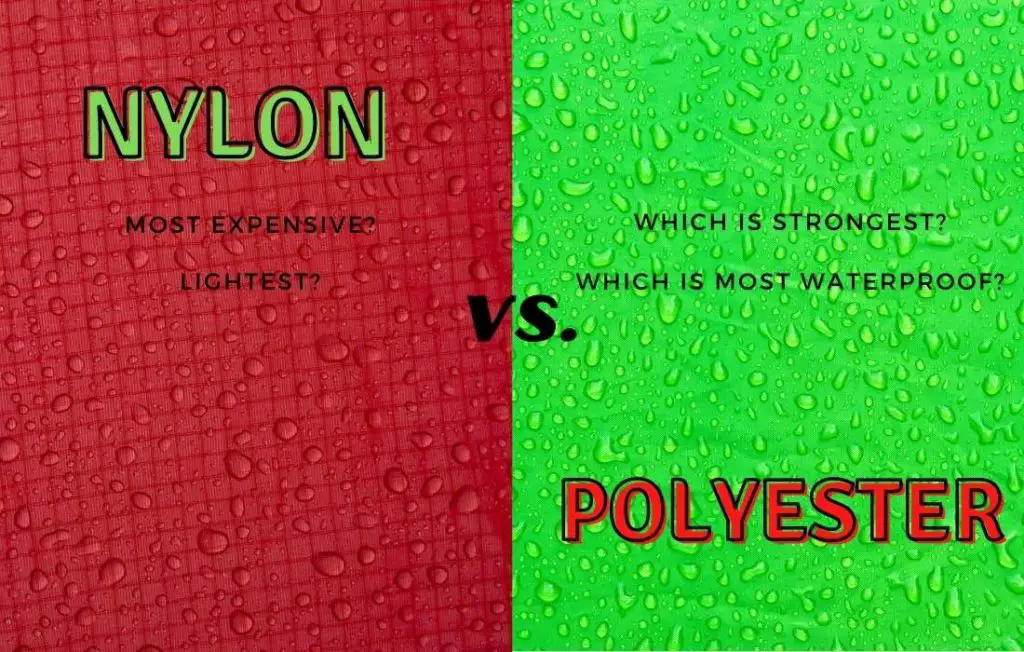
Click to see my post comparing the two materials for use in tents!
Polyester has more of an oily and sometimes fuzzy texture, but it can be made softer or rougher depending on the purpose.
Usually a stiffer material is used for the rain jacket’s outer layer and a softer, sometimes fluffy material, is used for the inside.
Synthetic materials will, however, newer win the price for softest or most comfortable materials so you should look towards wool, cotton or silk for a more natural soft and warm feel.
Stretchability of nylon vs. polyester
Nylon and polyester are both somewhat stretchy fabrics. However, nylon is more stretchable compared to polyester and can be stretched out more before it breaks.
The ability of nylon to stretch, however, does depend on the amount of water absorbed by the material.
Whereas completely dry nylon is almost brittle and not very stretchy, it becomes more elastic and almost sacky when soaked!
Is nylon more expensive than polyester?
Because the production of nylon is more time and energy-intensive, nylon is the more costly of the two materials.
The nylon fabric is usually also made via thinner threads, which demands more from the extrusion and spinning process than what is needed for polyester.
Both nylon and polyester can be made via recycled materials; however, it is much more expensive to reuse nylon compared to polyester.
Polyester can be made almost directly from reused bottles, clothing items, furniture etc. whereas nylon is more complicated to reuse and can be made from fewer materials such as old fishing nets or parachutes!
Nylon or Polyester for Winter Jackets (Which is Warmer?)
Nylon and polyester are also used for winter jackets used in colder climates. And here polyester or down feathers are also commonly used as the filling material or insulation.
Whereas nylon is the warmer of the two, polyester or cotton is often used because weight and breathability is less of a priority when a thick layer of insulation compromises both abilities anyways.
Therefore polyester is often the material of choice for winter jackets, but wool and cotton are also good options for winter jackets. At least for some of the layers and the filling/insulation layer is probably the most important layer to consider for winter jackets.
Whereas the degree of water resistance is also important, chances are that it will snow rather than rain and therefore the requirements for rainproofness are somewhat lower.
However, the main concern here is that the filling material does not get wet and collapses and thereby loses its ability to keep you warm!
Nylon vs. Polyester for Down Jackets
When it comes to down jackets it is very important to have a good outer layer that keeps the down dry.
Wet down will collapse, clump, and lose its insulation power, so you will want to prioritize water resistance over insulation when it comes to the other layer of the jacket. If not, you will have to through your jacket in the dryer with a few tennis balls to fluff the jacket back up!
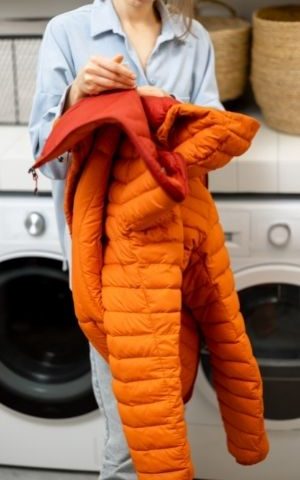
Here, nylon is most often used for high-end winter puffer jackets and works well if treated with a strong water-repellent agent, but polyester will be slightly better at keeping the water away from the sensitive down feathers!
And because the outer material is not as critical as for single-layer jackets, polyester is often the best choice for down jackets and other heavily insulated jackets as it is cheaper than nylon.
Gore-Tex vs. Nylon and Polyester
Gore-Tex is a trademarked technical fabric consisting of many layers with an expanded PTFE membrane at its core.
The Gore-Tex membrane is able to wick moisture while keeping the rain out, making it waterproof and breathable at the same time.
This is an ability that neither nylon nor polyester possesses, as breathable membranes are much more breathable than nylon or polyester alone.
Therefore it is hard to compare a simple layer of nylon or polyester directly to the multilayered membrane technology of Gore-Tex, but it is quite certain to be more waterproof and breathable than any single layer of nylon or polyester.
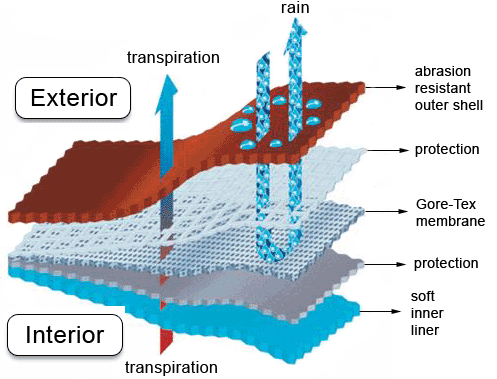
However, a Gore-Tex membrane is often covered in a layer of nylon or polyester to protect it against dirt and abrasion. The choice of material here will impact performance and weight in the same ways as already mentioned earlier in this post.
It should also not be a surprise that an advanced membrane jacket is much more expensive and heavier than that of a simpler nylon or polyester-based rain jacket or rain trousers.
A pure nylon jacket, for example, is also much easier to maintain and keep clean compared to a Gore-Tex jacket that will wear out fairly quickly (usually due to clogged membrane pores) and are harder to “revive” and clean.
Interestingly, the process of reviving a clogged membrane jacket is quite similar to that of re-fluffing a collapsed down jacket.
Nylon vs. Polyester Sustainability
The main environmental impact of nylon and polyester fabrics is the amount of fossil fuels, water and energy required for their production.
Nylon is a synthetic polymer made from petroleum, so its manufacture requires large amounts of energy and it is harder to make from reused products such as plastic bottles compared to polyester.
Whereas more and more rain gear is produced from reused plastics, most nylon and polyester is still produced directly from oils, which is not as sustainable as it could be.
In addition, both materials require large quantities of water for processing. Therefore, the use of these fabrics can have significant negative impacts on the environment compared to for example wool, cotton or down.
Conclusion
Overall, both nylon and polyester are good materials for a rain jacket or rain pants, but they do have their differences. Whereas polyester is cheaper and somewhat more water resistant, it is also heavier and less soft against the skin.
One thing to remember is that few jackets are constructed from one material alone and that the durability and functionality of the jacket depends on the combination of materials and the surface treatment used!
For the ultralight backpacker, nylon is the obvious choice whereas the occasional bird watcher or everyday user will be better off with cheaper polyester gear.
And there is of course more to a good camping trip. I just made a list of some of my favorite budget hiking gear including everything you need for a good night’s sleep in a tent.
And I have written about my favorite lightweight tents made from nylon or polyester here!
For more information on outdoor materials and backpacks from different brands, check my posts on Fjällrävens innovative material use, and how it compares to other outdoor brands like The North Face and Osprey.








